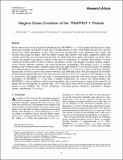Files in this item
Magma ocean evolution of the TRAPPIST-1 planets
Item metadata
| dc.contributor.author | Barth, Patrick | |
| dc.contributor.author | Carone, Ludmila | |
| dc.contributor.author | Barnes, Rory | |
| dc.contributor.author | Noack, Lena | |
| dc.contributor.author | Mollière, Paul | |
| dc.contributor.author | Henning, Thomas | |
| dc.date.accessioned | 2021-08-03T09:30:03Z | |
| dc.date.available | 2021-08-03T09:30:03Z | |
| dc.date.issued | 2021-07-26 | |
| dc.identifier | 274342073 | |
| dc.identifier | aa18459e-5e30-42cd-8bf4-39ddfd328022 | |
| dc.identifier | 000678601600001 | |
| dc.identifier | 85117805425 | |
| dc.identifier.citation | Barth , P , Carone , L , Barnes , R , Noack , L , Mollière , P & Henning , T 2021 , ' Magma ocean evolution of the TRAPPIST-1 planets ' , Astrobiology , vol. Ahead of Print . https://doi.org/10.1089/ast.2020.2277 | en |
| dc.identifier.issn | 1531-1074 | |
| dc.identifier.other | ORCID: /0000-0002-5418-0882/work/98197335 | |
| dc.identifier.uri | https://hdl.handle.net/10023/23703 | |
| dc.description | Funding: P.B. acknowledges a St Leonard’s Interdisciplinary Doctoral Scholarship from the University of St Andrews. L.C. acknowledges support from the DFG Priority Programme SP1833 Grant CA 1795/3. R.B.’s contribution was supported by NASA grant number 80NSSC20K0229 and the NASA Virtual Planetary Laboratory Team through grant number 80NSSC18K0829. Th.H. acknowledges support from the European Research Council under the Horizon 2020 Framework Program via the ERC Advanced Grant Origins 83 24 28. | en |
| dc.description.abstract | Recent observations of the potentially habitable planets TRAPPIST-1 e, f, and g suggest that they possess large water mass fractions of possibly several tens of weight percent of water, even though the host star's activity should drive rapid atmospheric escape. These processes can photolyze water, generating free oxygen and possibly desiccating the planet. After the planets formed, their mantles were likely completely molten with volatiles dissolving and exsolving from the melt. To understand these planets and prepare for future observations, the magma ocean phase of these worlds must be understood. To simulate these planets, we have combined existing models of stellar evolution, atmospheric escape, tidal heating, radiogenic heating, magma-ocean cooling, planetary radiation, and water-oxygen-iron geochemistry. We present MagmOc, a versatile magma-ocean evolution model, validated against the rocky super-Earth GJ 1132b and early Earth. We simulate the coupled magma-ocean atmospheric evolution of TRAPPIST-1 e, f, and g for a range of tidal and radiogenic heating rates, as well as initial water contents between 1 and 100 Earth oceans. We also reanalyze the structures of these planets and find they have water mass fractions of 0–0.23, 0.01–0.21, and 0.11–0.24 for planets e, f, and g, respectively. Our model does not make a strong prediction about the water and oxygen content of the atmosphere of TRAPPIST-1 e at the time of mantle solidification. In contrast, the model predicts that TRAPPIST-1 f and g would have a thick steam atmosphere with a small amount of oxygen at that stage. For all planets that we investigated, we find that only 3–5% of the initial water will be locked in the mantle after the magma ocean solidified. | |
| dc.format.extent | 2131124 | |
| dc.language.iso | eng | |
| dc.relation.ispartof | Astrobiology | en |
| dc.subject | Exoplanets | en |
| dc.subject | Terrestrial planets | en |
| dc.subject | Planetary atmospheres | en |
| dc.subject | Magma oceans | en |
| dc.subject | QB Astronomy | en |
| dc.subject | QC Physics | en |
| dc.subject | QE Geology | en |
| dc.subject | DAS | en |
| dc.subject | NIS | en |
| dc.subject.lcc | QB | en |
| dc.subject.lcc | QC | en |
| dc.subject.lcc | QE | en |
| dc.title | Magma ocean evolution of the TRAPPIST-1 planets | en |
| dc.type | Journal article | en |
| dc.contributor.institution | University of St Andrews. School of Physics and Astronomy | en |
| dc.contributor.institution | University of St Andrews. St Andrews Centre for Exoplanet Science | en |
| dc.identifier.doi | https://doi.org/10.1089/ast.2020.2277 | |
| dc.description.status | Peer reviewed | en |
| dc.identifier.url | https://arxiv.org/abs/2008.09599 | en |
This item appears in the following Collection(s)
Items in the St Andrews Research Repository are protected by copyright, with all rights reserved, unless otherwise indicated.

